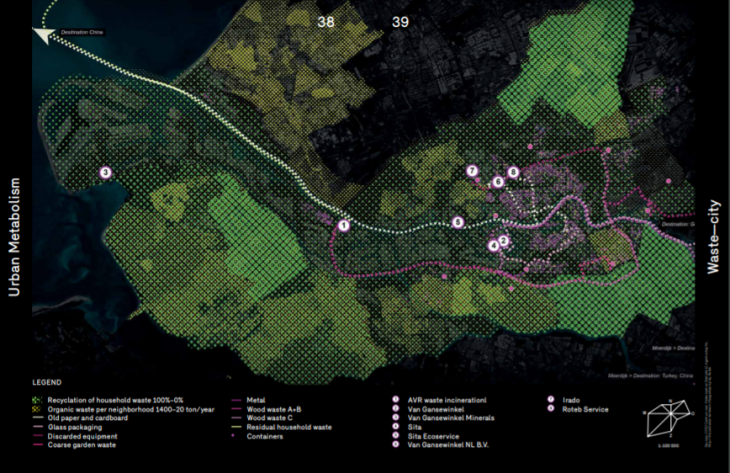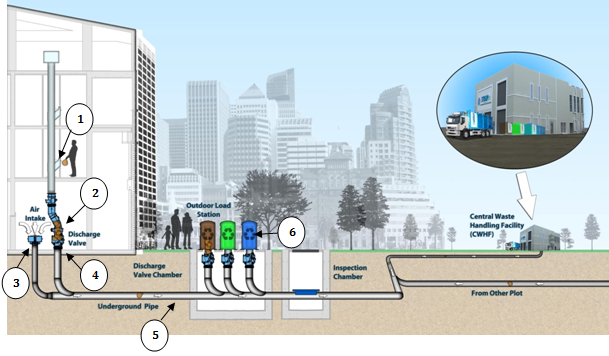In this critical reflection, we will examine the bio-metaphor “Urban Metabolism” in order to investigate its methodology of making cities more circular. From the research, we dive into the definition of metabolism as an urban metaphor using the FABrications Rotterdam study as a prime example and then critically reflect on the input-output focus, the absence of the adaptable citizen as a variable, and concerns of a one-time solution design of flows due to the fact that technology is causing these flows to evolve at a rapid pace. We then will use these concerns to see how we can better design simulation of these flows that could be built off studies like Rotterdam.
Let’s first define the word metabolism in order to deconstruct it:
“me·tab·o·lism /m??tab??liz?m/ Noun: the chemical processes that occur within a living organism in order to maintain life.”
It’s true that organisms, like cities, have different “chemical processes” that flow materials in and outside of their domain. This component of the metaphor has a certain amount of validity in that it allows urbanists to deconstruct these flows and design solutions to optimize the circular motion of these flows. This is the basis of Eric Fritjers research study “Urban Metabolism” at his lab FABrications, although he takes it a step further, saying “ It is therefore more interesting when we imagine the city not as a living organism, but regard it as an ecosystem.” While this metaphor is correct in ways, it’s important to realize it’s limitations.
In the Sustainable Development project of Rotterdam, the FABrications lab analyzed the flows of goods, people, waste, biota, energy, food, water, air, sand and clay. After mapping them out (the diagram below shows the mapping of the flow of waste in Rotterdam), he proposed 4 design strategies around these mappings.

https://iabr.nl/media/document/original/urban_metabolism_rotterdam.pdf
One of the strategies was to optimize the ways of which they collect raw materials from waste; including regional designs around aquafarming and bio-based material production, and city plans for phosphate recovery, protein collectives, residues supermarkets. He then measures the CO2 emission impact of proposing a circular strategy to turn organic waste into alternative forms of protein and a building renovation plan to reduce construction waste.
This study is taking both the industrial and urban ecological approach to urban metabolism on a particular city, of which Joshua Newell and Joshua Cousins argue in their study “The Boundaries of Urban Metabolism Towards a Political-Industrial Ecology” has limitations in that it has territorial bounds and serves to optimize the flow rather than the stock of the materials. Since the inputs to our systems are outweighing the outputs and our inputs are becoming more durable than before, this is building up more and more stock within our systems. In the article “Reshaping Urban Metabolism” by Paul H. Bruner, he states “If the stock is wisely, maintained, and reused, it can be a much more environmentally sound source of materials than primary mining.” What Bruner says is important, some of these circular design studies often pigeon-hole themselves in thinking about flow and inputs and outputs, whereas the stock may be the most important component in that it is building on itself within the actual system.
Another critique of the Rotterdam methodology is that it leaves out the human element of its metabolic metaphor. Humans are a large variable in some of these bottom-up solution designs. For example, in the analysis of emissions from food production, FABrications proposes circular processes that turn food waste into alternative proteins such as insects. However, will humans adapt to these alternative protein sources such and eat insects? Therefore, these solutions may be ignoring one of the more important approaches to urban metabolism, according to the UN report “Urban Metabolism for Resource-Efficient Cities” which describes the biosocial approach to include the “cooperation of change and progress in urban management.” Although more difficult to diagram and quantify than systems, flows, and ecologies in that there is less definiteness in its structure, the biosocial approach is truly a large part of the success of these solutions and should not be ignored in an apolitical construct.
Brunner states that “In all advanced service-oriented societies, and in particular in cities, consumer-oriented emissions are more important than production oriented emissions. This has implications for the design of environmental protection strategies.” Therefore, it may be the case that designing circular systems may be one of the same as designing cooperative consumers of these solutions. This isn’t to say that humans can be “controlled” completely by the political structures and regulations, but that urban researchers will need similar circular and analytical methodologies when investigating the citizen and how they are interacting with these strategies. For example, adapted citizens could be treated as inputs and stocks, while dis-adapting citizens could be treated as outputs. Clearly data privacy would play a large role in such an analysis, but such metrics can also be valuable in understanding the adapted human as a valuable, sustainable resource.
To look at the second component of the metaphor, cities are “living organisms”, however their metabolic systems evolve at a much faster rate due to the variability and unpredictability of technology. Homosapiens have been in existence over the last hundreds of millions of years with the structure of their metabolic processes remaining largely the same (despite pharmaceuticals being able to augment these processes), whereas the chemical processes of cities are adapting and evolving everyday. For example, e-mobility, micro-mobility, and autonomous vehicles have approached the mass market in the last 20 years, moving our cities towards a more sustainable, people-friendly mobility flow. Relatedly, the incumbent future of artificial intelligence will most likely have an impact in all of the flows mentioned in the Rotterdam study at some point in the future. Therefore, being able to keep up with and forecast the rise of technology will play a big role in urban flow strategies moving forward and the metaphor of metabolism only works in knowing that cities are living organisms with dynamic and evolving processes.
This brings a question of how we as urbanists should attack such metabolic issues. Since these flow analyses are often delivered as a reflection of the current problem state, the importance will be to move towards defining the problems and solutions to these flows in a more predictive, forward looking approach. This leads to the importance of advancement of computation and simulation technology when we are deconstructing these flows. Advances have already been made in economic modeling, noted in the Estudos Economicos (Sao Paulo) study “Modeling economic growth fuelled by science and technology.” However integrating this same concept of modeling into metabolic flow projections brings upon a variety of challenges, most notably due to the unpredictability and adaptability of these new technologies. However, models and simulations are starting to leverage prospective technologies. For example, a study performed by the World Economic Forum and Boston City Consulting predicted that half of the parking spaces in Boston will be needed when autonomous vehicles are fully integrated into society. This adds more space for the citizens of the city, changing the way people and correlated metabolic flows will perform.

https://www.wired.com/story/nacto-streets-self-driving-cars/
Additionally, underground automated waste collection systems are improving the way we sort through and recycle or waste. Currently live in around 30 countries with plans to expand into Europe and North America, this technology (with an example shown in the diagram below), will have a substantial impact to how our cities think about waste management.

https://www.stream-environment.com/how-does-stream-work
The key to integrating these technologies will be in identifying them early on, incorporating them into our models with a close investigation into the accuracy of when they will enter the market. Because of this, the accuracy of our simulation models will always need to be iterated upon throughout the advancement of new technologies within the respective flows. Flow mappings such as the Rotterdam study would then become the basis of a modular design of simulations that incorporate new technologies throughout time. The goal of these iterative models would be to line up the solution of a new system design with the new technologies that are in development, or at-least to factor it into the design decisions.
In conclusion, we are able to critically reflect on Urban Metabolism as a metaphor in constructing the circular designs of our cities. Using the Rotterdam study as an example, we examined the statistical focus of their flows, the absence of a socio-political analysis in designing the adaptable citizen, and weighed in on how technology is evolving at a rapid pace, changing the metabolic flows of our city. This raised some questions on how we map out these flows, where a focus on computation and forward-looking simulation will have to be ingrained within Urban Metabolism research. However like Eric Fritjer said in his talk using The Limits of Growth as an example, we still have to act now on improving these issues and can’t wait for new technologies to save the day. Nonetheless, the structure metaphorically of Urban Metabolism is sound in its approach to deconstruct the sustainability of city systems, and is inspiring to urbanists in terms of how they want to build off this framework.
References:
Brunner, Paul H. “Reshaping Urban Metabolism.” Journal of Industrial Ecology, vol. 11, no. 2, 2007, pp. 11–13., doi:10.1162/jie.2007.1293.
Dijst, Martin, et al. “Exploring Urban Metabolism—Towards an Interdisciplinary Perspective.” Resources, Conservation and Recycling, vol. 132, 2018, pp. 190–203., doi:10.1016/j.resconrec.2017.09.014.
Newell, Joshua P., and Joshua J. Cousins. “The Boundaries of Urban Metabolism.” Progress in Human Geography, vol. 39, no. 6, 2014, pp. 702–728., doi:10.1177/0309132514558442.
Ribeiro, Leonardo Costa, et al. “Modeling Economic Growth Fuelled by Science and Technology.” Estudos Econômicos (São Paulo), vol. 40, no. 2, 2010, pp. 319–340., doi:10.1590/s0101-41612010000200003.
Shaver, Katherine. “City Planners Eye Self-Driving Vehicles to Correct Mistakes of the 20th-Century Auto.” The Washington Post, WP Company, 21 July 2019, www.washingtonpost.com/transportation/2019/07/20/city-planners-eye-self-driving-vehicles-correct-mistakes-th-century-auto/.
Urban Metabolism for Resource Efficient Cities. 2017, resourceefficientcities.org/wp-content/uploads/2017/09/Urban-Metabolism-for-Resource-Efficient-Cities.pdf.
Urban Metabolism Rotterdam. 2014, iabr.nl/media/document/original/urban_metabolism_rotterdam.pdf.
Circular Design Reflection on Urban Metabolism is a critical reflection paper developed at IaaC, Institute for Advanced Architecture of Catalonia at Master in City & Technology in (2019/2020) by:
Students: Andrew Saltzman & Eli Munn
Faculties: Mathilde Marengo